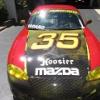
Nitrogen for Tires.
#21

 Posted 12-20-2011 02:05 AM
Posted 12-20-2011 02:05 AM

Nitrogen will also hold pressure better. I blew up a balloon with air and it was deflated in 3 days, I inflated a balloon with Nitrogen and it was still inflated 3 weeks later. It's just one of the little things and they add up.
Joe


#22

 Posted 12-20-2011 02:28 AM
Posted 12-20-2011 02:28 AM

- Glenn likes this
#23

 Posted 12-05-2013 09:18 AM
Posted 12-05-2013 09:18 AM

For those using the TR Motorsports in the 25mm, does that have two valve stem holes, or just one? I saw a fellow competitor's set and his had two. Just had a set delivered, and they had one.
#24

 Posted 12-05-2013 12:34 PM
Posted 12-05-2013 12:34 PM

So if I generally start my tires at 24-26 to get them to 35-35lbs after puling in from the track, where would you guess I should start with Nitrogen?


#25

 Posted 12-05-2013 12:42 PM
Posted 12-05-2013 12:42 PM



#26

 Posted 12-06-2013 11:20 AM
Posted 12-06-2013 11:20 AM

NASA Utah SM Director





#27

 Posted 12-06-2013 09:20 PM
Posted 12-06-2013 09:20 PM

We have multiple sets of TR Motorsports 30 offset wheels and they all have dual valve stems. Didn't think there was a difference with the 25's....
The +25's are BMW wheels so they don't have the dual valves.
http://philstireservice.com Enkei Team Dynamics The Miata Wheel Motegi Apex Wedsport Hoosier Toyo BFG Michelin Nankang Federal
#28

 Posted 12-07-2013 05:14 PM
Posted 12-07-2013 05:14 PM

Nitrogen will also hold pressure better. I blew up a balloon with air and it was deflated in 3 days, I inflated a balloon with Nitrogen and it was still inflated 3 weeks later. It's just one of the little things and they add up.
Joe
Joe-Your experiment had a flaw somewhere. Gases effuse at a rate inversely proportional to their molecular mass. In other words, light gases leak through pores faster than heavier gases. Here's what each gas weighs:
-water vapor =18 g/mol
-nitrogen=28 g/mol
-oxygen=32 g/mol
As you can see, only water vapor would leak through the pores of your balloon quicker and I seriously doubt there was enough moisture in your balloon to make a significant difference. Air, which is 78% nitrogen and 21% oxygen has almost the same average mass of pure nitrogen.
Jeff
#29

 Posted 12-09-2013 08:14 AM
Posted 12-09-2013 08:14 AM

The +25's are BMW wheels so they don't have the dual valves.
That explains it. Though given our general desire for a wider track, I'm sure there's a good reason why folks are continuing to order 30's. Can someone enlighten me?
#30

 Posted 12-09-2013 08:27 AM
Posted 12-09-2013 08:27 AM

I'm sure there's a good reason why folks are continuing to order 30's. Can someone enlighten me?
Use spacers for a tuning aid.



#31

 Posted 12-09-2013 02:27 PM
Posted 12-09-2013 02:27 PM

I put 32 pounds of air in my tires. Why don't they feel any heavier?
- George Willet likes this


#32

 Posted 12-09-2013 03:10 PM
Posted 12-09-2013 03:10 PM

#33

 Posted 12-09-2013 05:10 PM
Posted 12-09-2013 05:10 PM

I put 32 pounds of air in my tires. Why don't they feel any heavier?
Love it, but can someone actually tell me if there is a pressure increase difference between standard air from my compressor vs. filling with Nitrogen so I know where to start tires cold?


#34

 Posted 12-09-2013 05:50 PM
Posted 12-09-2013 05:50 PM

What do the tire guys use to mount tires these days? I remember they used to slop a bunch of soapy water on the bead. So if that water is sealed in the tire, it seems like potential for varying moisture levels, even with nitrogen.


#35

 Posted 01-30-2015 06:12 PM
Posted 01-30-2015 06:12 PM

- SaulSpeedwell likes this
#36

 Posted 01-30-2015 06:45 PM
Posted 01-30-2015 06:45 PM

What do the tire guys use to mount tires these days? I remember they used to slop a bunch of soapy water on the bead. So if that water is sealed in the tire, it seems like potential for varying moisture levels, even with nitrogen.
My guy has used liberal amounts of WD40 for decades, including all his own race tires for FA and other classes. I've wondered about it both in terms of what it might do to the rubber and whether it increases the risk of a tire rotating on the rim, but he swears by it and I've had no complaints.


#37

 Posted 01-30-2015 06:53 PM
Posted 01-30-2015 06:53 PM

Mark Bennett turned me on to P-80 it goes on wet but leaves no residue. perfect for tires and bushing.
http://www.ipcol.com/shopexd.asp?id=16
Frank
TnT Racing
SCCA Ohio Valley Region




#38

 Posted 01-31-2015 09:43 AM
Posted 01-31-2015 09:43 AM

Joe-Your experiment had a flaw somewhere. Gases effuse at a rate inversely proportional to their molecular mass. In other words, light gases leak through pores faster than heavier gases. Here's what each gas weighs:
-water vapor =18 g/mol
-nitrogen=28 g/mol
-oxygen=32 g/mol
As you can see, only water vapor would leak through the pores of your balloon quicker and I seriously doubt there was enough moisture in your balloon to make a significant difference. Air, which is 78% nitrogen and 21% oxygen has almost the same average mass of pure nitrogen.
Jeff
Do you work for the New England Patriots on weekends filling footballs with very moist air before games in a warm room?




#39

 Posted 01-31-2015 09:46 AM
Posted 01-31-2015 09:46 AM

I put 32 pounds of air in my tires. Why don't they feel any heavier?
That's a lot of unsprung weight to be carrying per corner. But if that's the way you like it....
Chris
Happiness is a dry martini and a good woman ... or a bad woman.
- George Burns
#40

 Posted 01-31-2015 11:53 AM
Posted 01-31-2015 11:53 AM

"...eases installation of tight-fitting rubber parts by reducing the force needed for insertion."
Sounds like it might be useful for runoffs tech too.
Mark Bennett turned me on to P-80 it goes on wet but leaves no residue. perfect for tires and bushing.
- George Willet likes this
Full disclosure: SMAC chairman, my opinions do not reflect anything to do with the SMAC unless specifically stated.
Todd Lamb
Atlanta Speedwerks
www.atlspeedwerks.com
SpeedShift Transmissions - reliability and performance
Spec Miata / Spec Boxster / Spec Cayman specialist
Spec MX-5 Challenge Series Director
Global MX-5 Cup team











0 user(s) are reading this topic
0 members, 0 guests, 0 anonymous users




 Sign In
Sign In Create Account
Create Account




 Back to top
Back to top Report
Report











